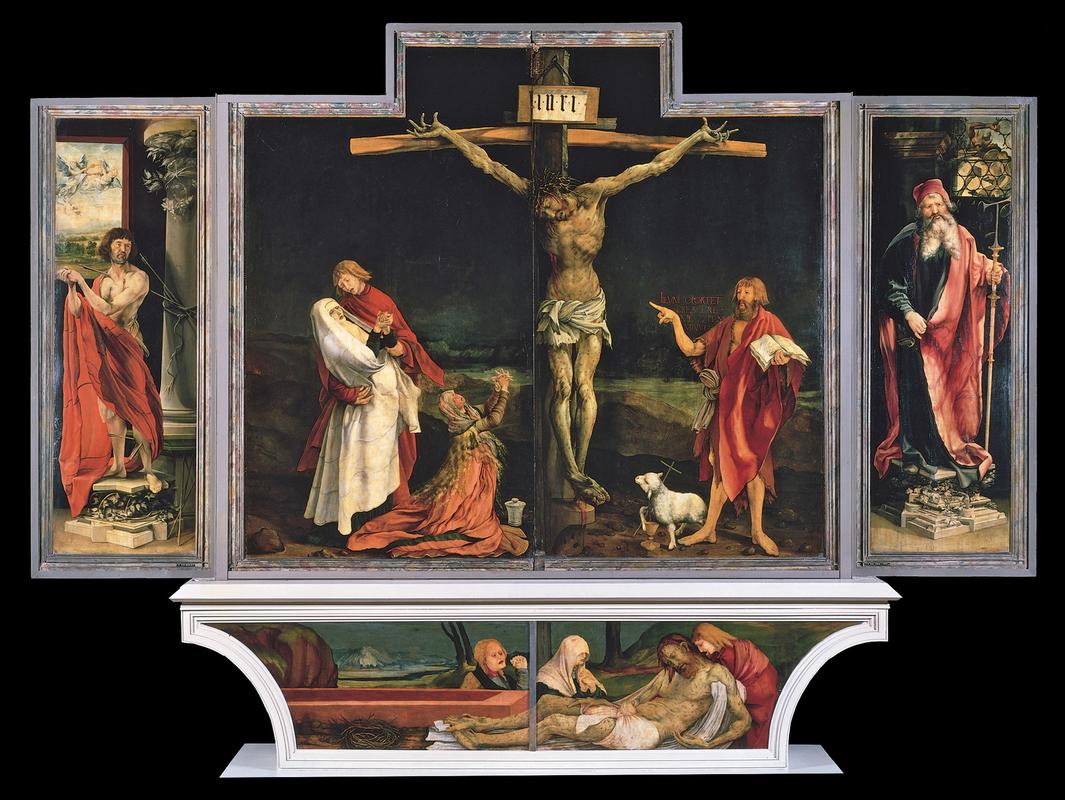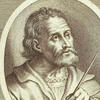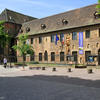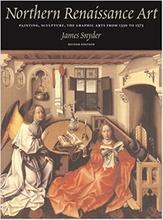More about The Isenheim Altarpiece
- All
- Info
- Shop

Sr. Contributor
Part gigantic Rubik's cube, part medical textbook, the Isenheim Altarpiece is one of the world's most brutal crucifixion scenes...and one of the most beloved artworks ever made.
The altarpiece was commissioned for a remote Antonite monastery chapel serving as a hospital helping victims of St. Anthony's fire. The illness constricts blood flow to the extremities, causing hands and feet to rot while, additionally, the victim slowly goes insane through vivid nightmarish hallucinations. The cause is consumption of a common fungus called ergot that infects rye and other grains in damp harvests throughout northern Europe. If you were trying to eat on a budget in the 1500s, you had a pretty fair chance of getting St. Anthony's fire, now called ergotism.
One of the many panels shows the temptation of St. Anthony. In the bottom corner lies a lethargic cloaked fellow covered in sores. The symptoms of new patients were compared with his for diagnosis. That sounds a little unprofessional off the cuff, however, imagine how much more fun it would be to get your diagnosis in comic book form. Just saying.
The monks had a pretty standard method for treating ergotism. They gonna get you drunk, get you drunk off St. Anthony's humps. Or his toes, maybe. Or collarbone. Whatever's available. They'd mash a proprietary recipe of secret herbs and spices in wine and then steep a Saint Anthony relic in there like it's teatime. Called it saint venage. If the ergotism didn't drive you crazy, drinking a cocktail made from human parts while staring at the Isenheim Altarpiece just might do the trick.
The Antonites were loaded and viewed Grünewald's work as their greatest treasure. When the French Revolution gained steam across the country, the Altarpiece was transferred to the Unterlinden convent where it now resides as the Unterlinden Museum's big draw. This single work inspired an opera in honor of Grünewald, underwhelmingly titled "Mathis the Painter." It's like if "The Dark Knight" were called "Bruce the Rich Guy." Picasso was down with Grünewald, too. He drew the Isenheim Altarpiece 55 times to learn its secrets. After 55 times, somebody probably held an intervention to make him stop.

Contributor
Many consider this to be the best painting by a German artist, ever.
Many are probably wrong, but still, this is a pretty awesome crucifixion scene. Also, the side panel on the left shows St. Anthony, who does not seem to care in the least that there are a bunch of arrows lodged in his leg.
The Unterlinden Museum in Colmar, France, and Grünewald fans everywhere celebrated the 500th anniversary of the altarpiece in 2012.
One of the sets of interior panels depict St. Anthony visiting St. Paul the Hermit on one side, and the other side shows numerous plague victims and God's angels helping St. Anthony fight off disease-ridden demons. The animals act like they're part of a Disney movie and bring the Saints food.
Featured Content
Here is what Wikipedia says about Isenheim Altarpiece


The Isenheim Altarpiece is an altarpiece sculpted and painted by, respectively, the Germans Nikolaus Hagenauer and Matthias Grünewald in 1512–1516. It is on display at the Unterlinden Museum at Colmar, Alsace, in France. It is Grünewald's largest work and is regarded as his masterpiece.
It was painted for the Monastery of St. Anthony in Issenheim near Colmar, which specialized in hospital work. The Antonine monks of the monastery were noted for their care of plague sufferers as well as for their treatment of skin diseases, such as ergotism. The image of the crucified Christ is pitted with plague-type sores, showing patients that Jesus understood and shared their afflictions. The veracity of the work's depictions of medical conditions was unusual in the history of European art.
Check out the full Wikipedia article about Isenheim Altarpiece















